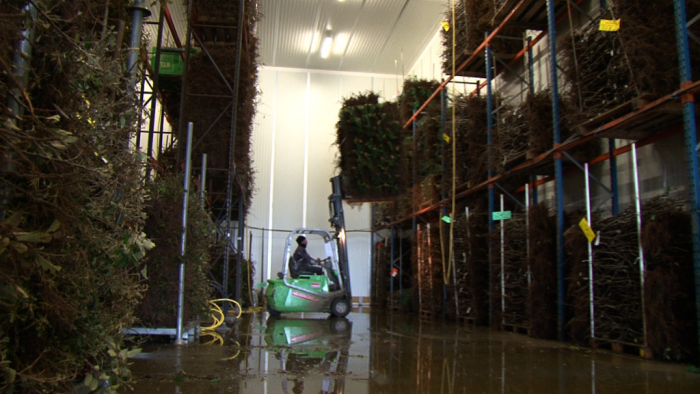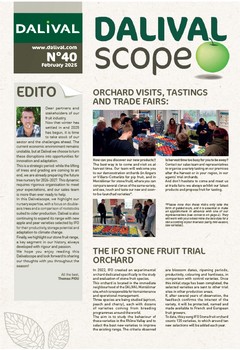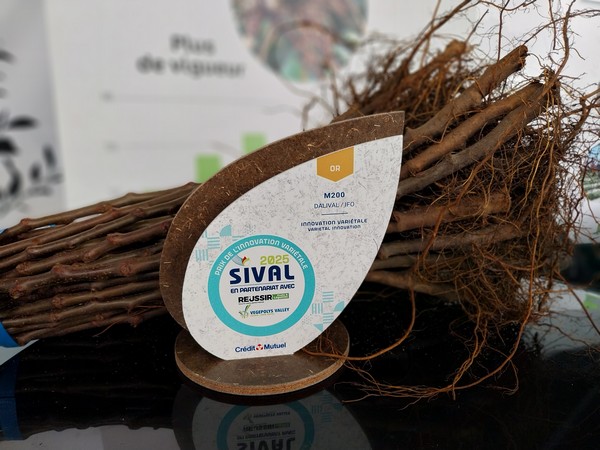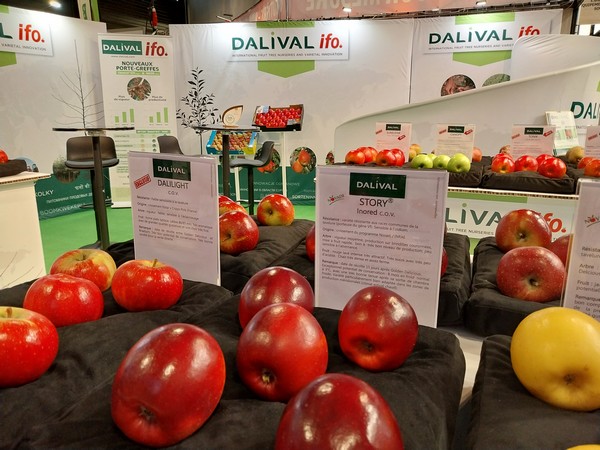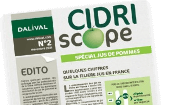 Nous contacter
Nous contacter
The nursery
The DALIVAL trees:
In its 3 nurseries, Dalival mainly offers different types of trees:
Two year old trees (knipboom):
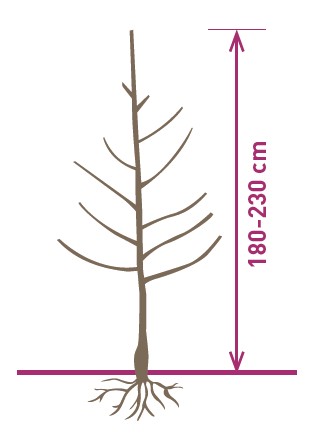 The knipboom tree is benchgrafted in winter of the first year and planted in spring. It is cut back during winter in the second year and the tree is lifted in the following autumn. Its main characteristic is the yield potential ranging from 6 to 9 kg per tree in the second year. Full yield can be expected in the fourth or the fifth year depending on the orchard technology. Knipbooms represent 80% of Dalival tree production.
The knipboom tree is benchgrafted in winter of the first year and planted in spring. It is cut back during winter in the second year and the tree is lifted in the following autumn. Its main characteristic is the yield potential ranging from 6 to 9 kg per tree in the second year. Full yield can be expected in the fourth or the fifth year depending on the orchard technology. Knipbooms represent 80% of Dalival tree production.
Production scheme of a Knipboom:
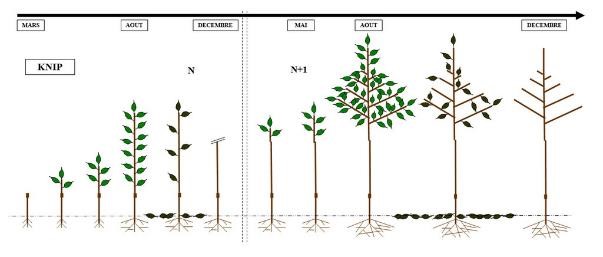
Maiden trees:
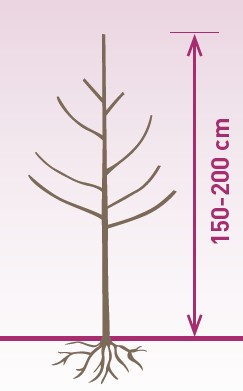 A maiden tree is budded in the field in summer time and lifted in autumn of the following year. A yield of 5 to 7 kg per tree can be expected in the second year and full yield is reached within the fifth year, depending on the orchard technology.
A maiden tree is budded in the field in summer time and lifted in autumn of the following year. A yield of 5 to 7 kg per tree can be expected in the second year and full yield is reached within the fifth year, depending on the orchard technology.
Production scheme of a maiden tree: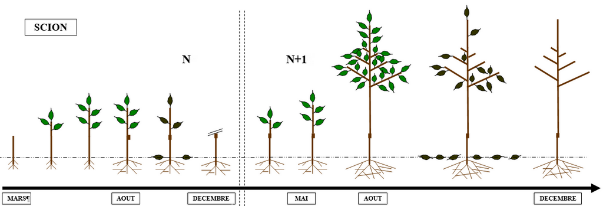
9 month trees (from benchgrafts or sleepy eyes):
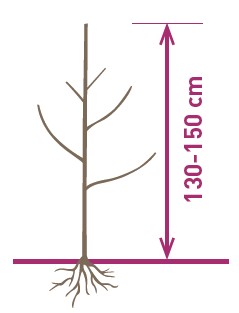 A 9 month tree is benchgrafted in winter, planted in spring and lifted in the following autumn. Depending on the year and on the varieties, these trees can have more or less branches. A yield potential ranging from 3 to 4 kg per tree in the second year. A yield of 3 to 4 kg per tree can be expected in the second year and full yield can be reached within the fifth year depending on the orchard technology.
A 9 month tree is benchgrafted in winter, planted in spring and lifted in the following autumn. Depending on the year and on the varieties, these trees can have more or less branches. A yield potential ranging from 3 to 4 kg per tree in the second year. A yield of 3 to 4 kg per tree can be expected in the second year and full yield can be reached within the fifth year depending on the orchard technology.
Production scheme of a 9 month tree:
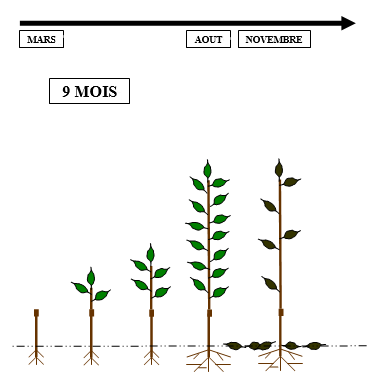
Maiden trees budded as sleepy eye:
A sleepy eye is a rootstock which is planted during the winter of year N and on which one or 2 bud(s) of a variety is (are) budded in August/September.
This “set” is sold during the winter of year N+1.
The advantages of this type of trees are the quick production (a variety identified within the summer can be sold as early as the following winter) and the cheaper tree price due to the shorter nursery cycle.
The disadvantage is the longer work to train the trees after plantation in the orchard (especially cutting of the buds) – please see our plantation advice within the Advice section.
This type of tree is very common for peach and nectarine, less for apricot and very rare for cherry trees due to the fragility of the cherry buds.
if the training of the trees is successfull, when the trees get in third leave, it is very difficult to determine if they were standard maidens or from sleepy eyes.
Varieties:
The varieties propagated belong to 5 product families:
- Dessert apples
- Pear trees
- Stone fruit
- Cider apple trees
- Pollinators
Trees are graded depending on their branches and height.
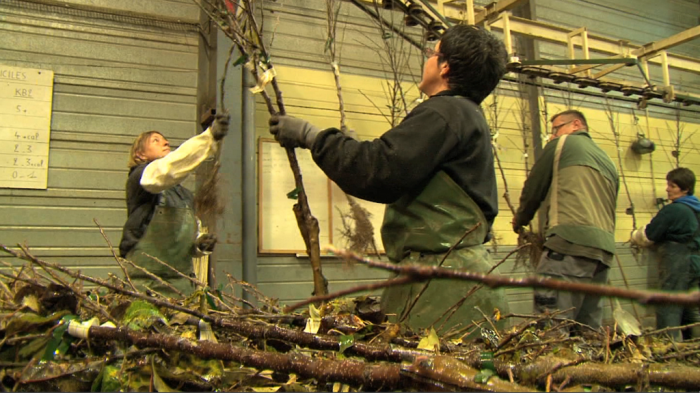
Trees of virus free varieties are controlled and certified by the CTIFL. The delivery process is carried out with utmost care: trees are delivered in a bunch of 10 trees attached with a rubber band on the rootstock to avoid damaging the bark. In addition, they are protected by a net on the aerial part to avoid breaking the branches. Finally, the trees are placed in pallets to prevent handling and facilitate unloading.
For further information: check our contact page
Research
Discover IFO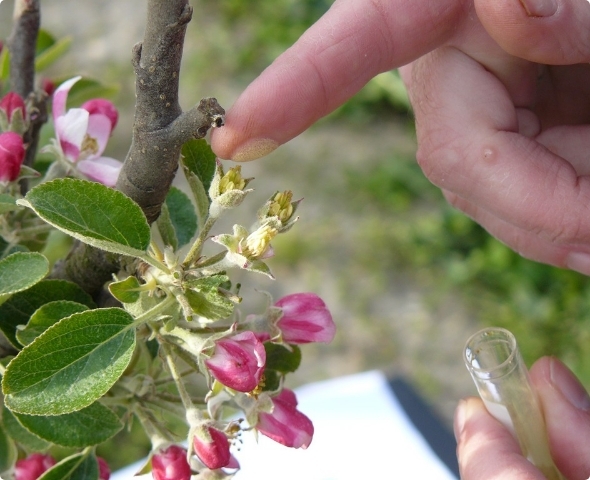
News
SEE ALL THE NEWSRequest Quotation - Trade fair SIVAL 2025
 English
English Français
Français Deutsch
Deutsch Español
Español Italiano
Italiano Русский
Русский Polski
Polski
